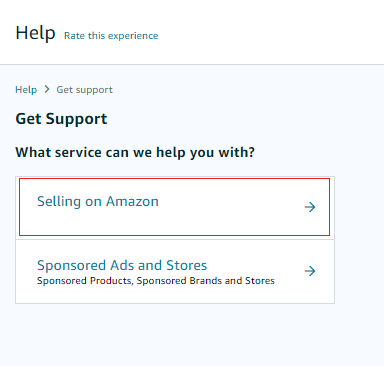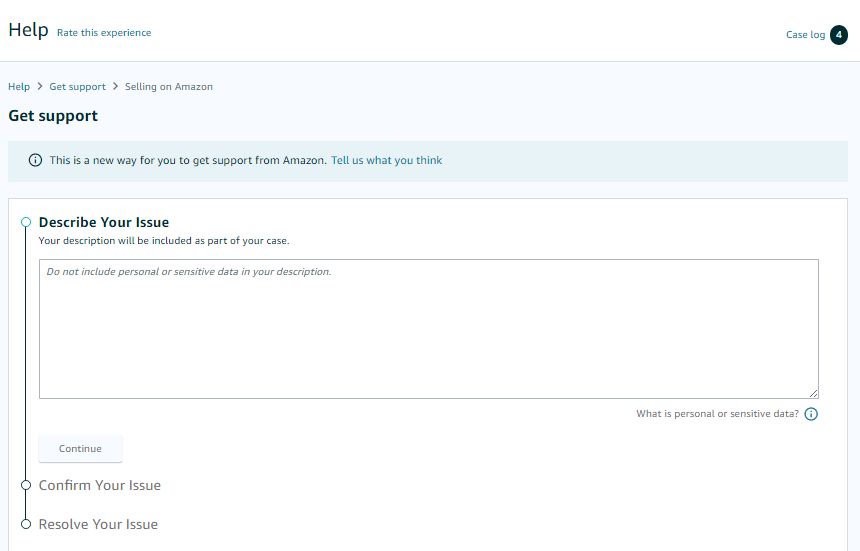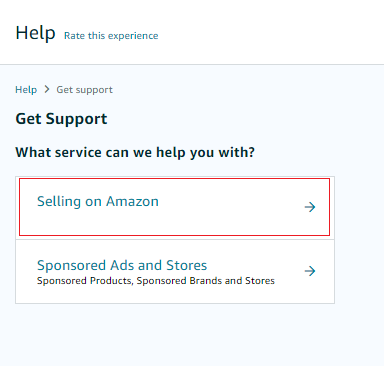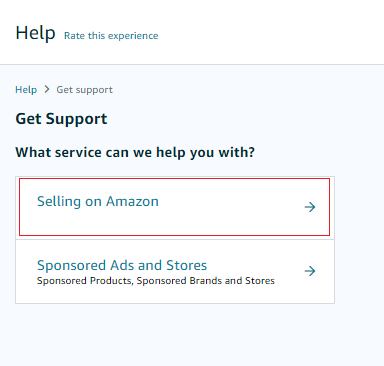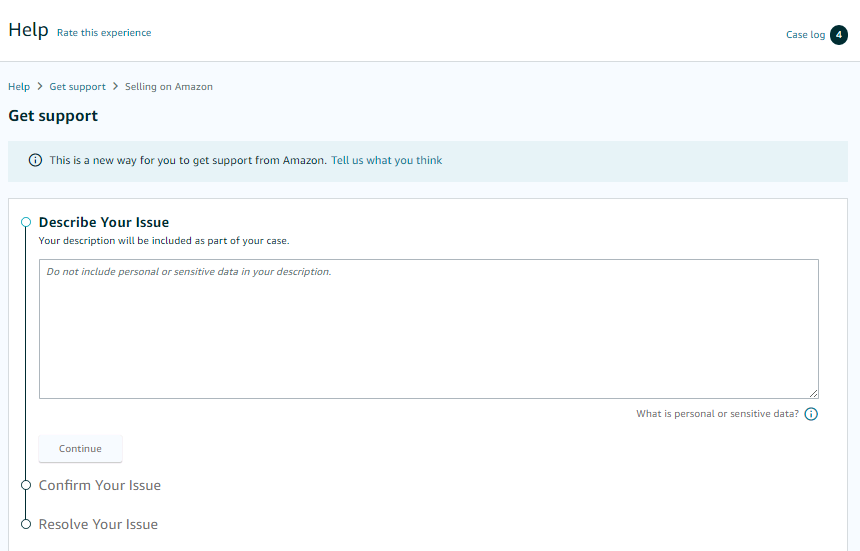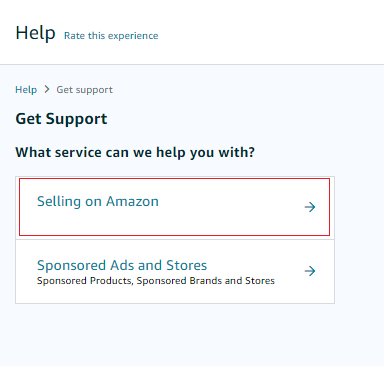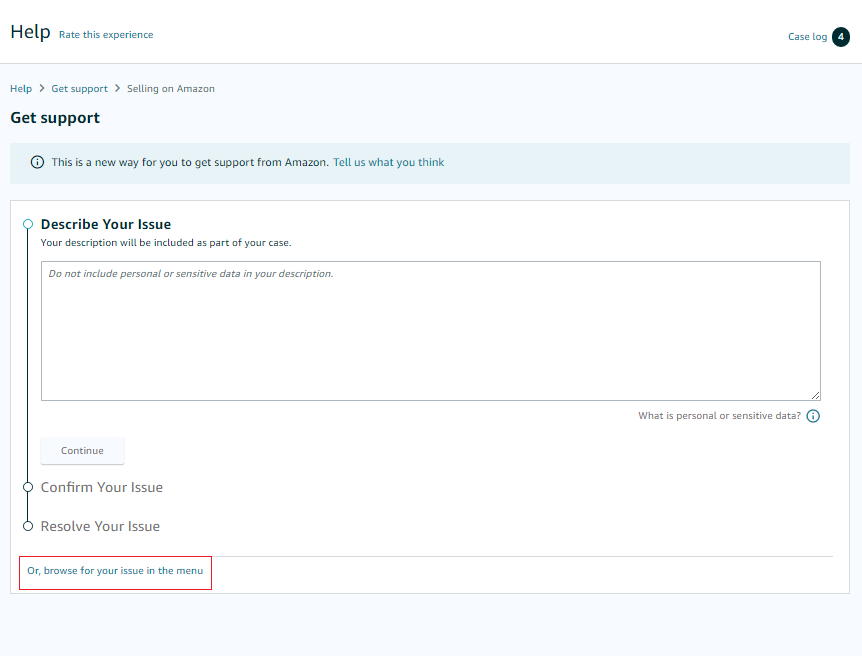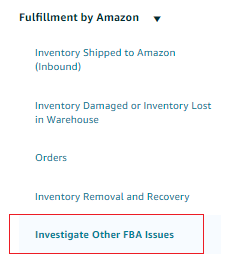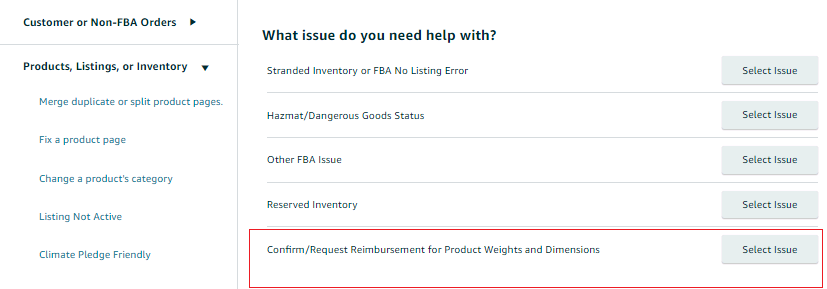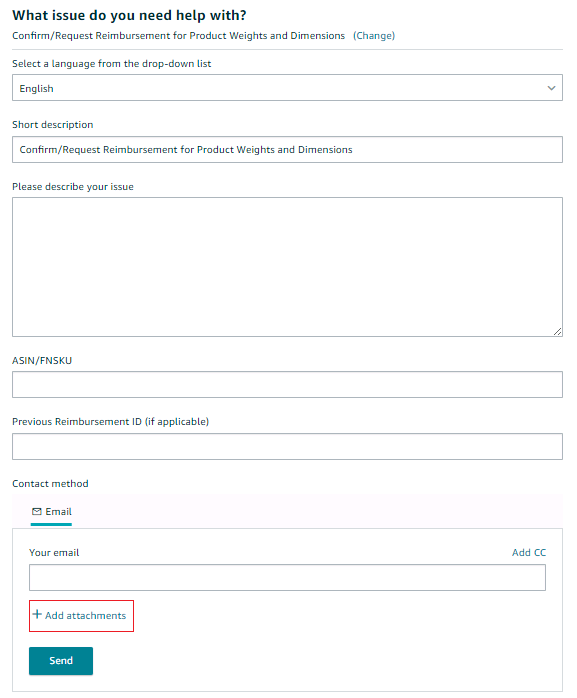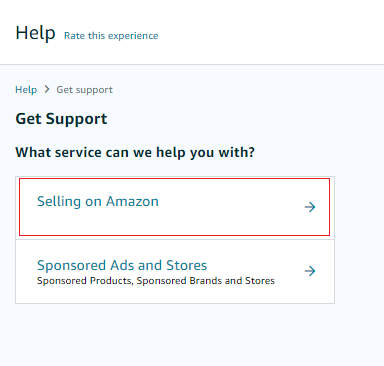Sellerise Smart Alerts Tool
Instructions for responding to key notifications
About Instruction
These instructions give recommendations for what an Amazon seller should do when they receive the following notifications:
-
Hijacker - this notification means that, on the seller’s listing, offers of the same product from other sellers (hijackers) have appeared.
Information about the hijacker is available in the notification: Seller ID, Condition of the product, type of storage of the goods (FBA/FBM), the Listing Price of the item on the hijacker’s listing, the Shipping Price of goods from the hijacker, the number of Feedbacks about the hijacker, and the hijacker’s Rating.

-
Inactive Offer - this notification means that the specified offer of the seller (ASIN) has become inactive (for example, due to the lack of goods in stock at Amazon, blocking of goods due to lack of documents, lack of important information in the backend of the listing, etc.). So, the listing exists, but the offer is not available: the product may be available from other sellers that trade on the same listing or a different SKU may be available from the same seller on the same listing.

-
Listing Suppression - this notification means that the seller’s specified listing (ASIN) has been suppressed and excluded from the search results on Amazon.

-
Stranded Inventory - this notification means that the specified item in the FBA warehouse is stranded and cannot be sold due to a listing block, lack of documents, or other reasons. Additional fees may apply for such inventory.
The notification also provides the following details of the stranded inventory: SKU, Strand Day, the number of units stored in the warehouse that can / cannot be sold (Fulfillable / Unfulfillable Qty), the number of received/reserved units (Inbound Shipped / Reserved Qty), the reason for blocking (Stranded Reason).

-
Adult - this notification means that the specified listing (ASIN) has been tagged in Amazon as offering "adult products".

-
Problems with Shipment - this notification means that Amazon has requested additional information about the specified product batch (ASIN) received at the FBA warehouse (the bar code is not readable, the declared weight and parameters of the boxes do not match, there are problems with the documents, etc.).


-
Dimensions Changed - this notification means that for the specified product (), Amazon has changed the dimensions by which the marketplace commissions, as well as items storage and fulfillment fees, are calculated.
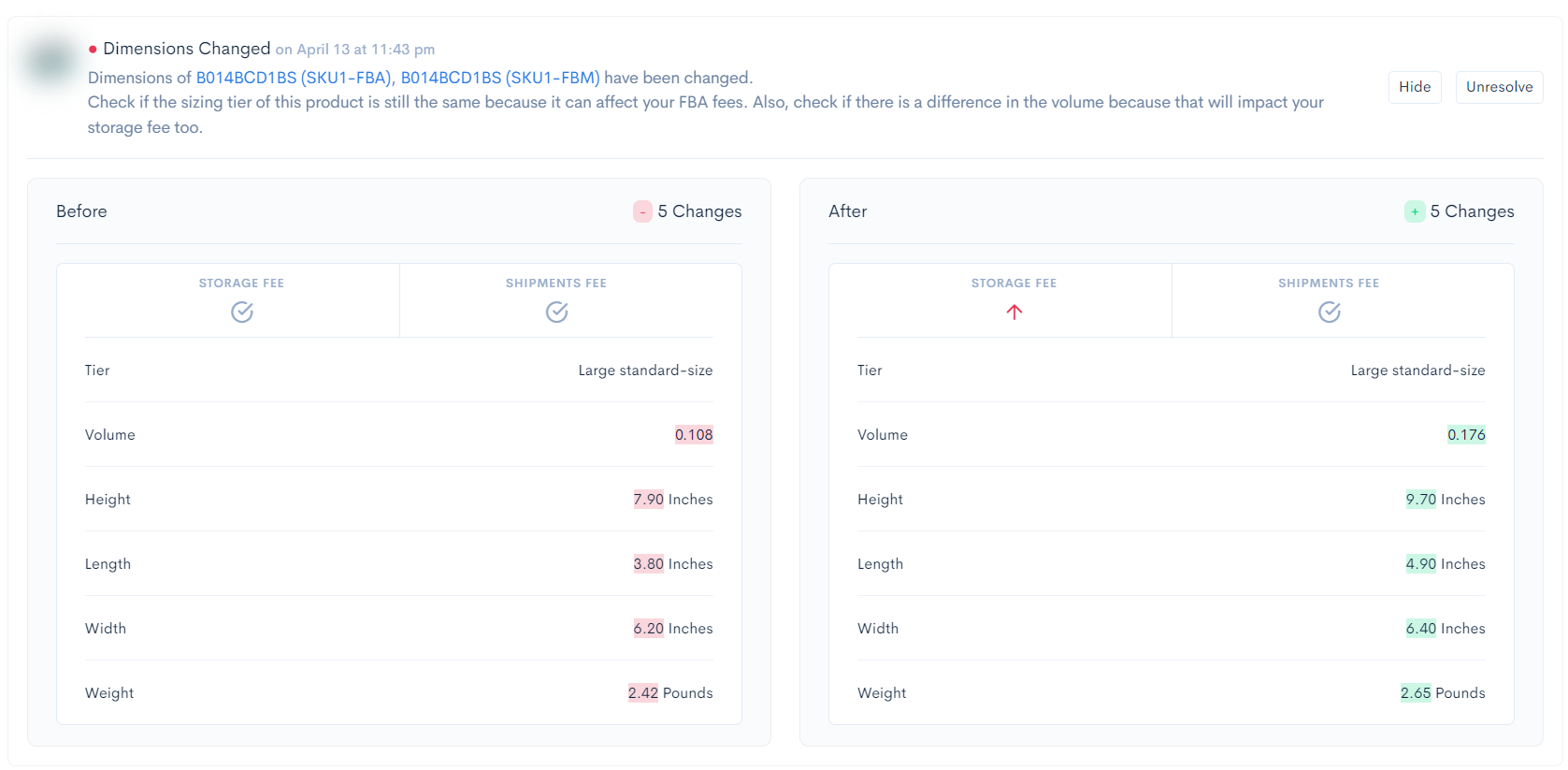
-
Category Changed - this notification means that the category of the specified listing () was changed:

What to do if you receive
a Hijacker notification
If the product listing where the hijacker appeared is protected by a registered Trademark in the country of sale and/or is enrolled in the Amazon Brand Registry, the seller has the option to remove the hijacker using the Amazon Project Zero tool, developed by the marketplace specifically for such cases, or by selecting the Report a violation option.
Both tools are available on the website, https://brandregistry.amazon.com. However, the process of removing the hijacker depends on whether the product is enrolled in the Amazon Brand Registry.
For products enrolled in the Amazon Brand Registry, do the following:
-
In the Protect menu, select Project Zero.

-
Select the country of sale of the product where the hijacker was found, and enter the ASIN of your product in the search bar.
This tool also allows you to find images "borrowed" from a registered product listing by other sellers without permission, and to submit requests to the marketplace regarding the actions of such sellers. To do an image search, click the Browse button in the Search by image panel of the Project Zero window, then upload an image.
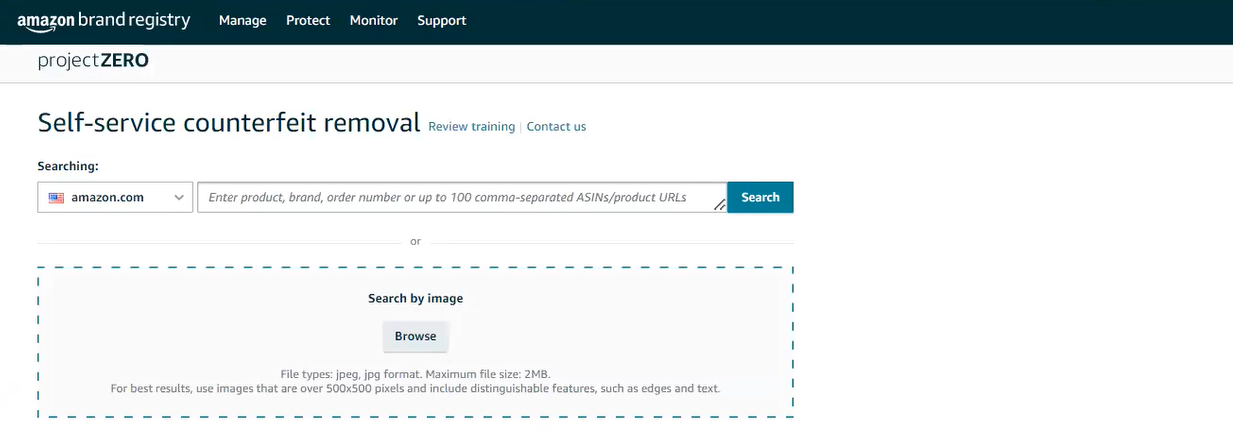
-
The tool window will display product information, while the Show offers tab will list all the offers of the product available on Amazon in the selected country. For each available offer, you can see the seller details (Sold by), the product Condition (new or used), the country of dispatch of the goods (Ships from), and the Price of the product + its shipment cost.
To mark a seller who has been identified as a hijacker, just tick a check in the box to the left of their name, and then click Next above the upper right corner of the product information panel.
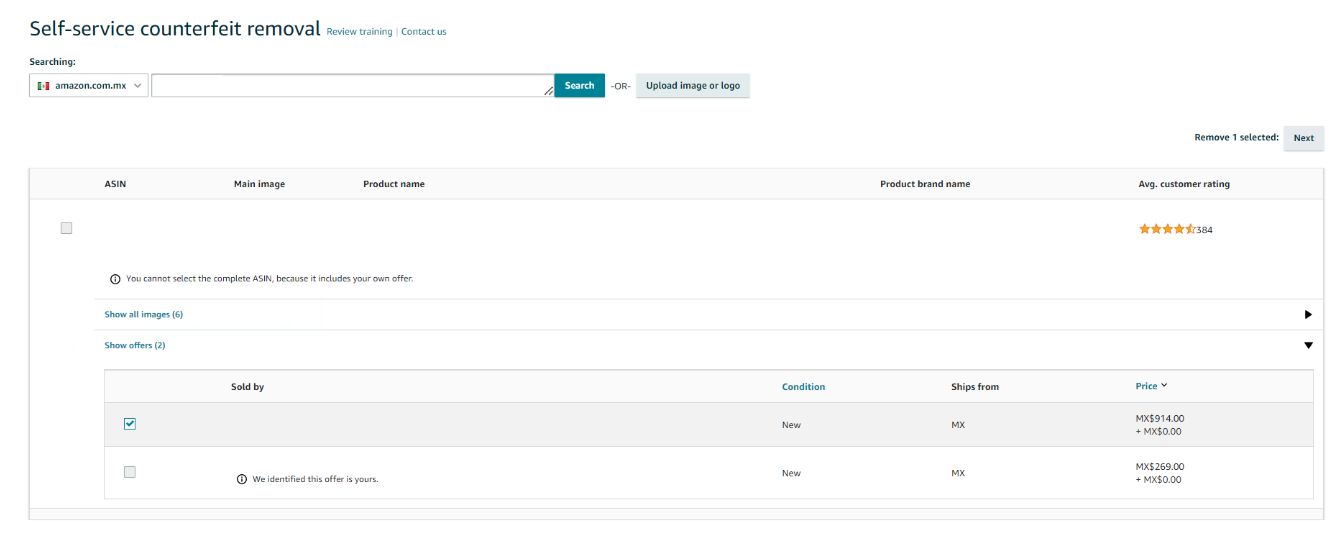
-
In the window that opens, use the drop-down menu to select the brand name under which the product was registered in the Amazon Brand Registry, and then click the Remove counterfeit button. The hijacker will be removed within 10 minutes.

If the product is not enrolled in the Amazon Brand Registry in the country of the listing with a hijacker, the tool will not allow automatic removal, even if it is registered in other countries.
For example, if a product brand is in the amazon.com (Amazon US) Brand Registry, this method will not help to remove a hijacker selling goods in Mexico, if the product is not in the amazon.com.mx Amazon Brand Registry.
For products sold under a registered trademark, but which are not in the Amazon Brand Registry in the country where the hijacker is present, do the following:
-
In the Protect menu, select Report a violation.

-
Select the country of sale where the hijacker has been found, and in the search bar, enter the ASIN of your product, just as you would if it were in the Amazon Brand Registry.
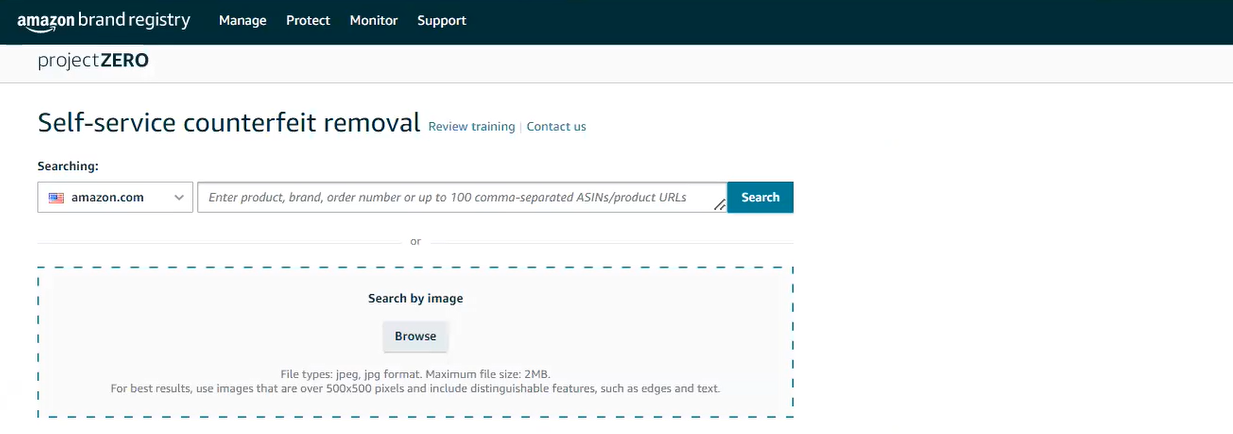
-
The tool window will display product information, while the Show offers tab will list all the offers of the product available on Amazon in the selected country. For each available offer, you can see seller details (Sold by), product Condition (new or used), the country of dispatch of the goods (Ships from), and the Price of the product + its shipment cost.
To mark a seller identified as a hijacker, just tick the check in the box to the left of their name, and then, in the Select Issue drop-down menu (above the upper-right corner of the product information panel), select Trademark infringement.
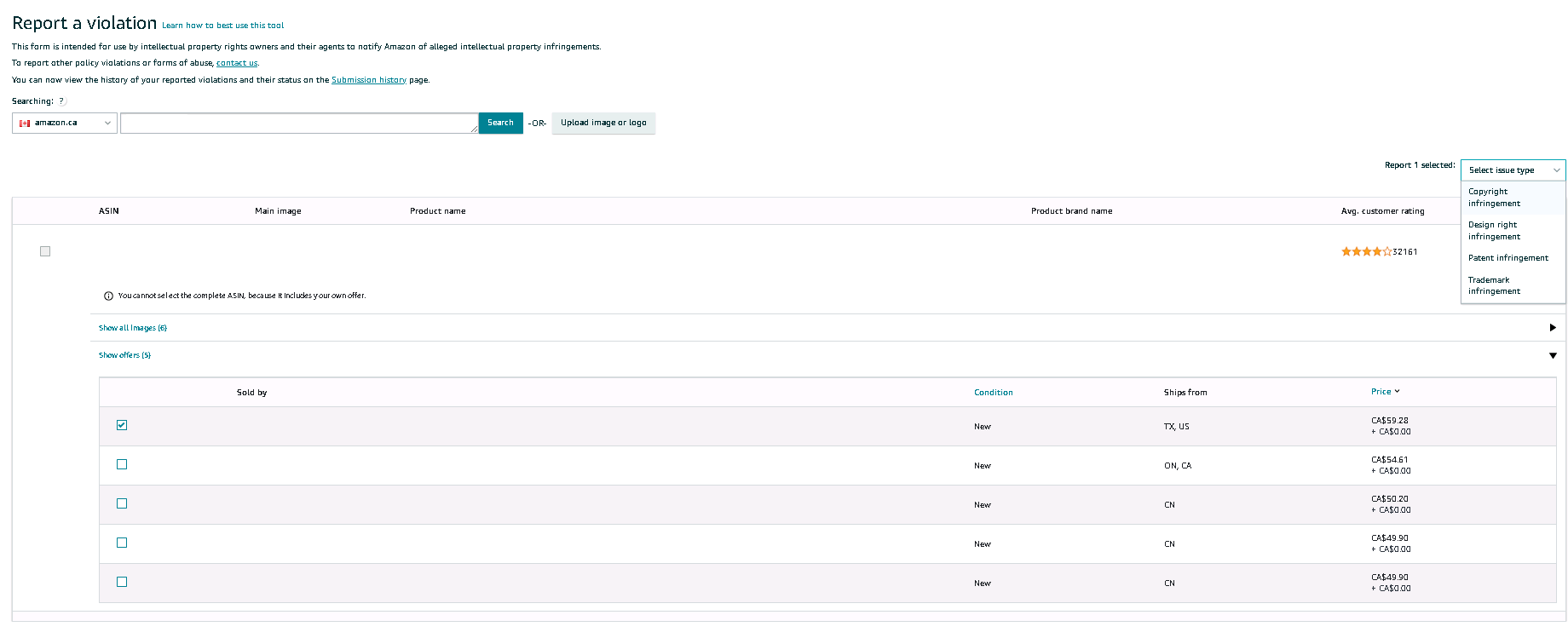
-
In the window that opens, you must specify additional information. As data is filled in, new panels will be displayed in the window
In particular:
- When answering the question, What best describes your issue?, you should select A product or its packaging has my trademark on it;
- In the Brand name section, you must specify the name of the registered trademark;
- When answering the question, Which of this brand’s trademarks do you believe is being infringed? select No one of these trademarks from the drop-down menu if the product is not in the Amazon Brand Registry (if it is, use the Project Zero tool as described above to remove the hijacker);
- In the Is the trademark registered? section, you must also specify No if the product is not in the Amazon Brand Registry.
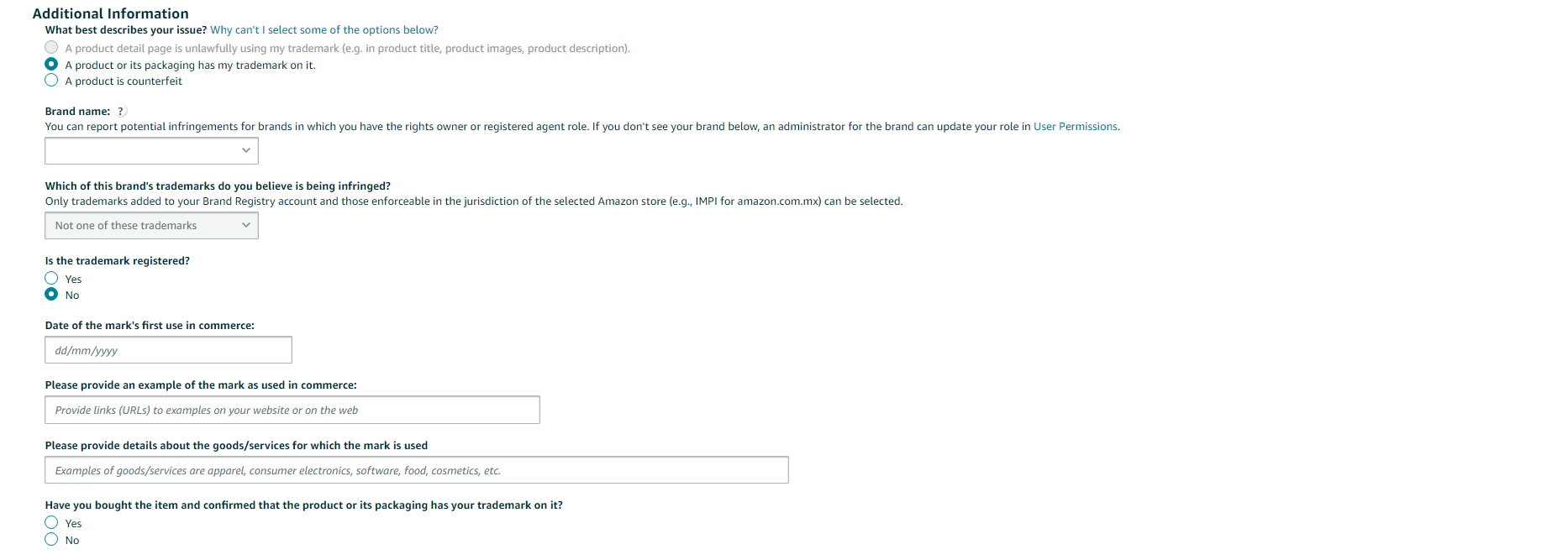
Pay special attention to filling in the fields that appear at the end of the report template. You must fill in the following:
- Date of the mark’s first use in commerce;
- Please provide an example of the mark as used in commerce (this can be a link to a website, etc.);
- Please provide details about the goods/services for which the mark used.
An important success factor in filing a trademark infringement report is that you purchased the product from a hijacker. Therefore, in the Have you bought the item and confirmed that the product its packaging has your trademark on it? section, you must choose Yes, then in the What is the order ID number? field, indicate the order number of the hijacker’s goods.
Also, in the Please provide more information to help us understand your issue section, you can specify any additional data confirming the misuse of the trademark. The very fact of selling the same product, in this case, is not a reason to remove the hijacker - it is the misuse of the brand that is a violation, and it is important to focus on this.
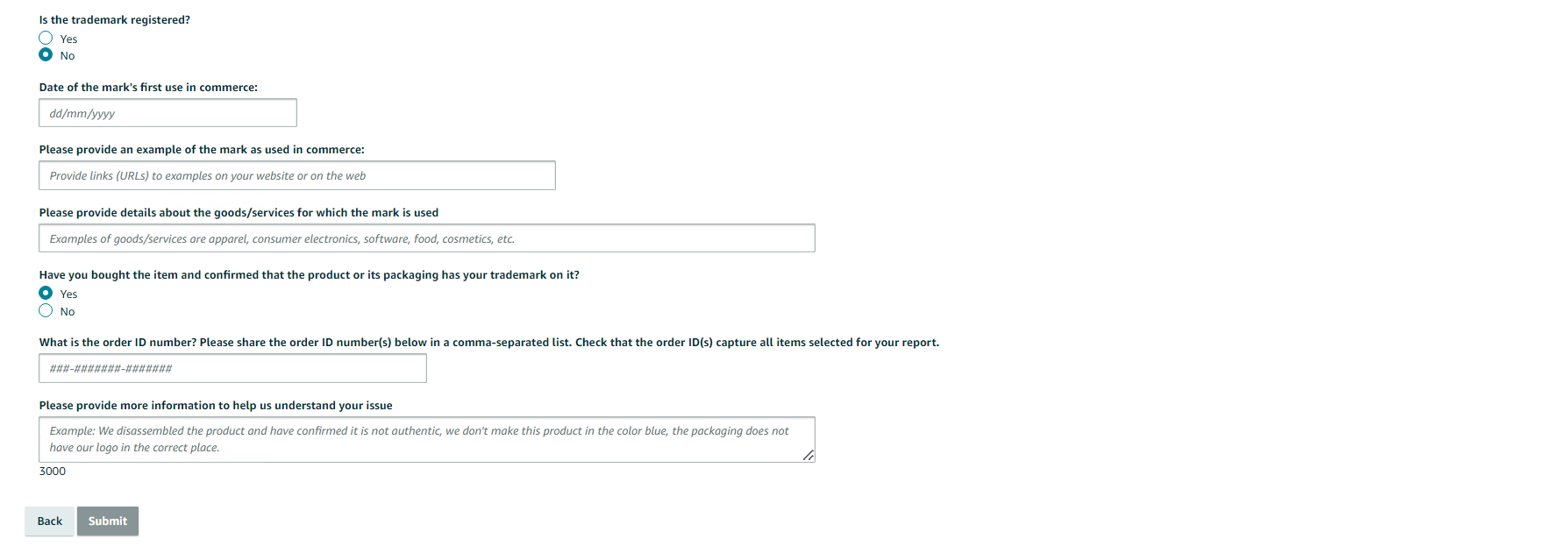
-
To submit the report, click the Submit button at the bottom of the window.
You can find out about the decision made by the marketplace regarding the hijacker by selecting Submission history in the Monitor menu:

What to do when you receive
an Inactive offer notification
If you receive an Inactive Offer notification, the main task is to establish the reasons for the inactivity of the offer, for which it is necessary, first of all, to check the availability of inventory in the warehouse, check the listing for completeness of the information (including data in the listing backend), etc.
In part, the information contained in the notification can help to solve this problem. After the cause is found, it must be rectified - replenish the inventory, enter the missing information, etc.
If it has not been possible to determine the reason for the inactivity of the offer, you should submit a request to Amazon Seller Support by clicking the Get Support button at the bottom of the <ш>Help page on Amazon Seller Central.
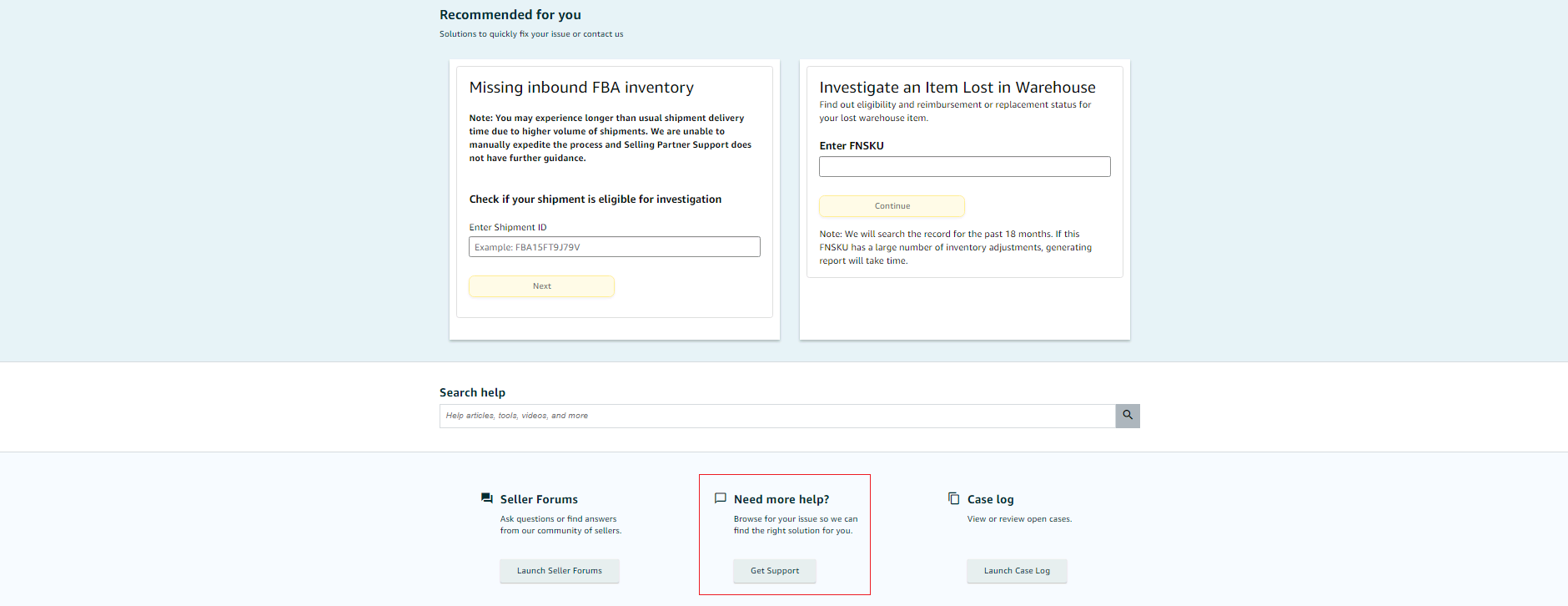
In the menu that appears on the screen, select the Selling on Amazon section. Then in a new Describe Your Issue window, you need to describe the situation, and provide the ASIN and SKU of the product, as well as the status indicated in the notification.
What to do when you receive
a Listing Suppression notification
In order to find out the reason for the exclusion of a listing from the search results, select Inventory → Manage All Inventory on Amazon Seller Central.
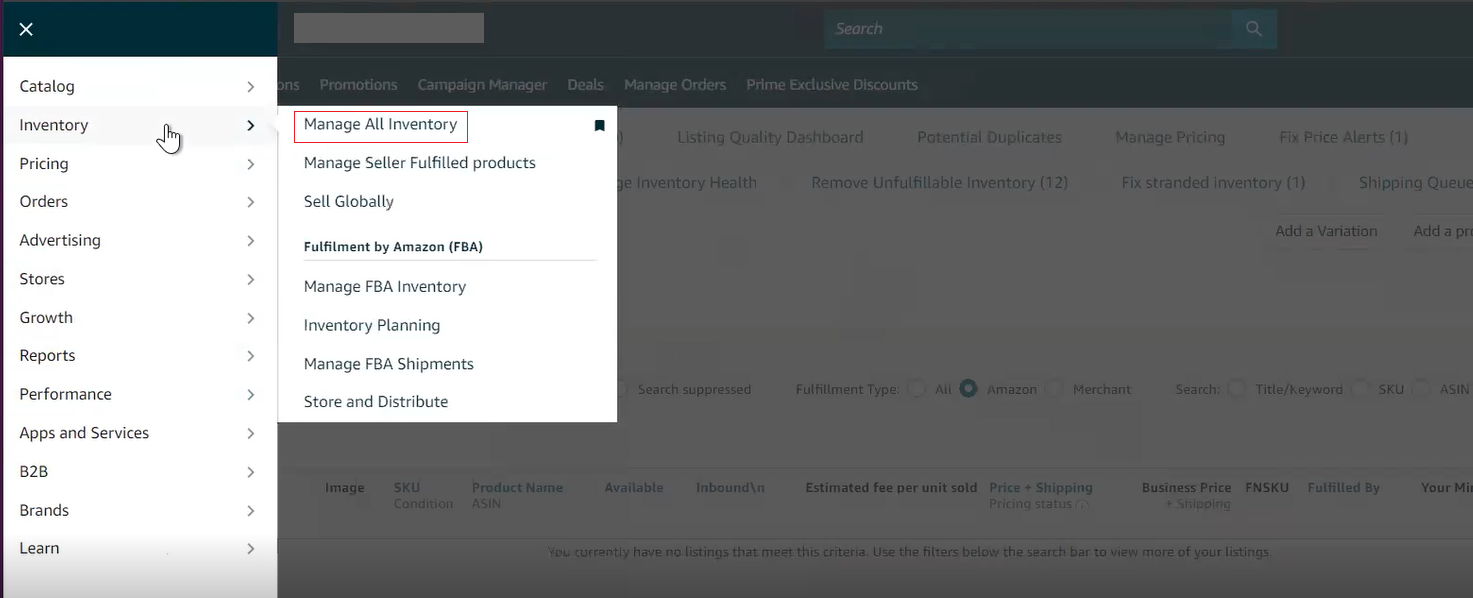
In the window that opens, select the Search Suppressed and Inactive Listings tab and then the Search Suppressed section containing data about problematic listings:
- Product Details, ASIN, and SKU;
- Reason and Status Change Date (the reason and date of exclusion of the listing from the search results);
- Issue Description


What to do if you receive
a Stranded Inventory notification
In order to find out and address the reason that the goods were “stranded” in the Amazon warehouse, go to the Amazon Seller Central menu and select Inventory → Manage All Inventory
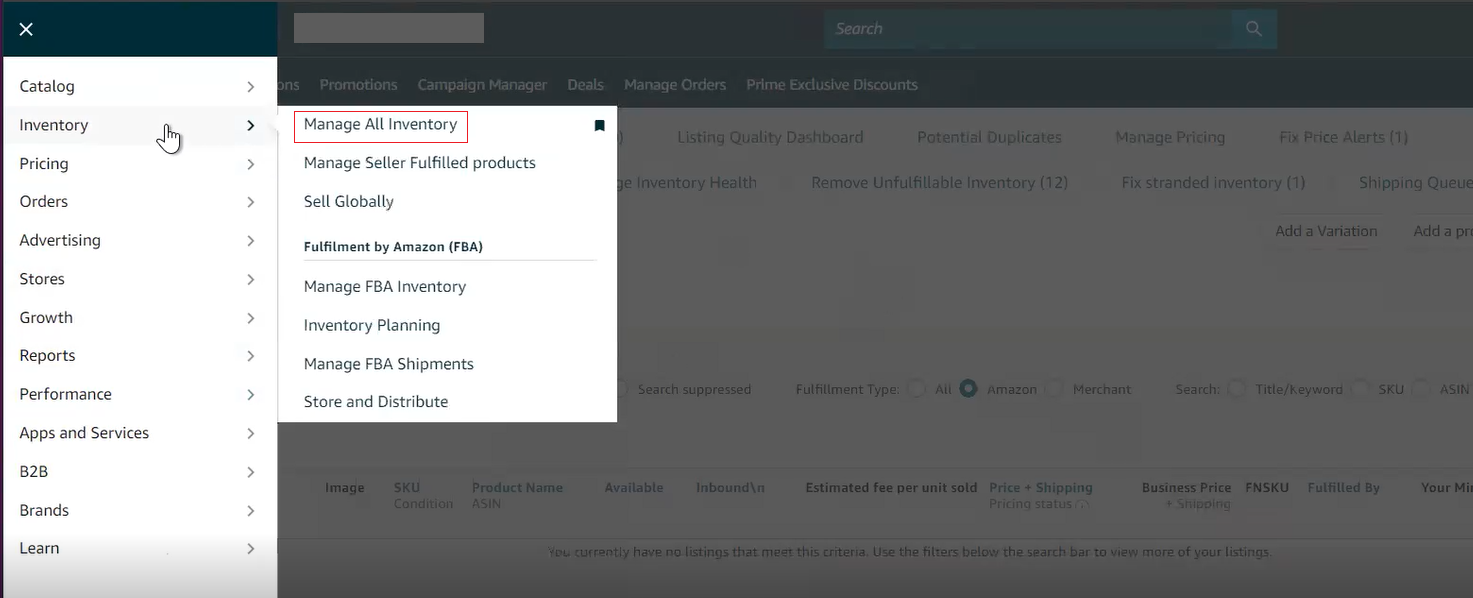
In the window that opens, select the Fix Stranded Inventory tab, which contains data about problematic items.

For each item, you can see:
- the SKU / Condition of the product;
- the FN-SKU code;
- Product Name / ASIN code;
- Your Price of the product;
- the Available number of items in stock at Amazon;
- Date of stranded event;
- Auto removal date;
- Stranded reason - how the product received this status;
- Fulfilled by - the fulfillment services provider.

When you click the Appeal menu button to the right of the product data fields, the following options become available:
- Appeal;
- Edit listing;
- Create removal order;
- Refresh stranded reason;
- Delay auto removal for 30 days.
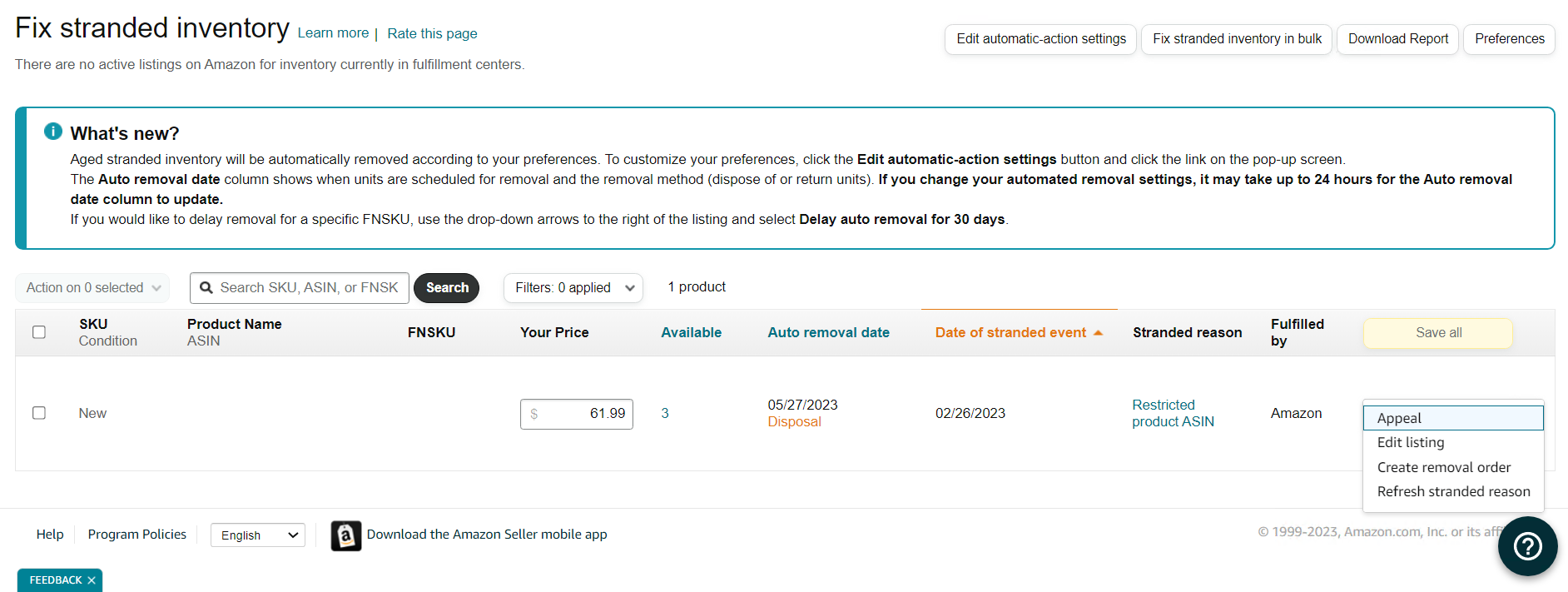
To see detailed information about the reasons for the Stranded status, hover over the short description in the Stranded reason panel - additional details will show up in a pop-up window.
If data about the product specified in the notification is missing from the list of goods in the Fix Stranded Inventory tab, you need to check if the product listing is blocked. To do this, in the menu, click Performance → Account Health on Amazon Seller Central, and check if there are any notifications about violations of the marketplace policies (in the Policy Compliance panel).
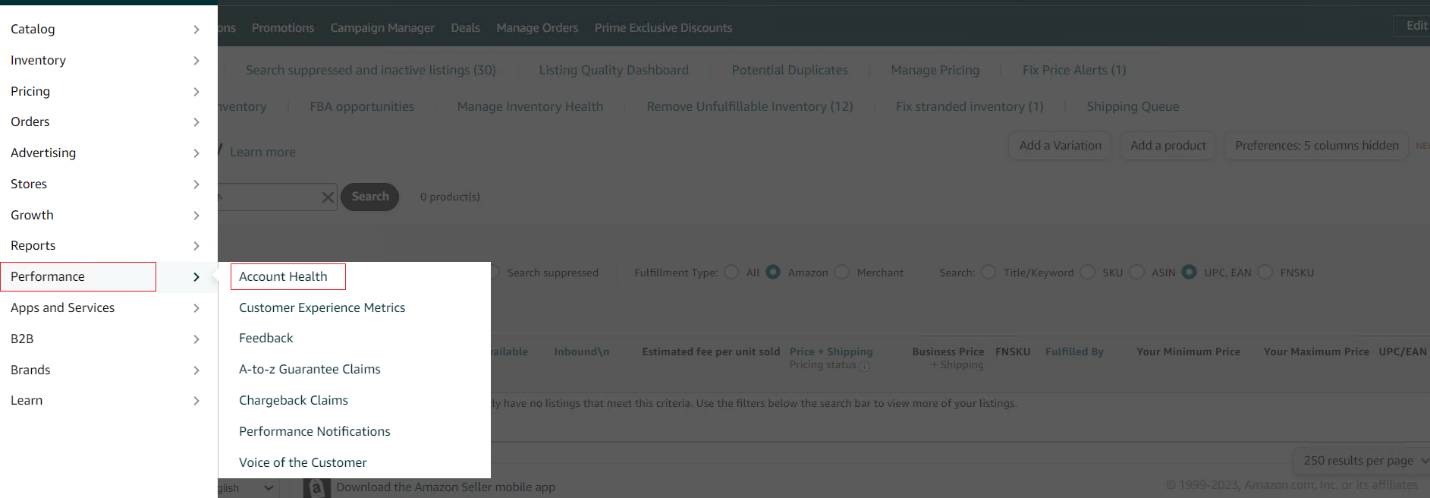
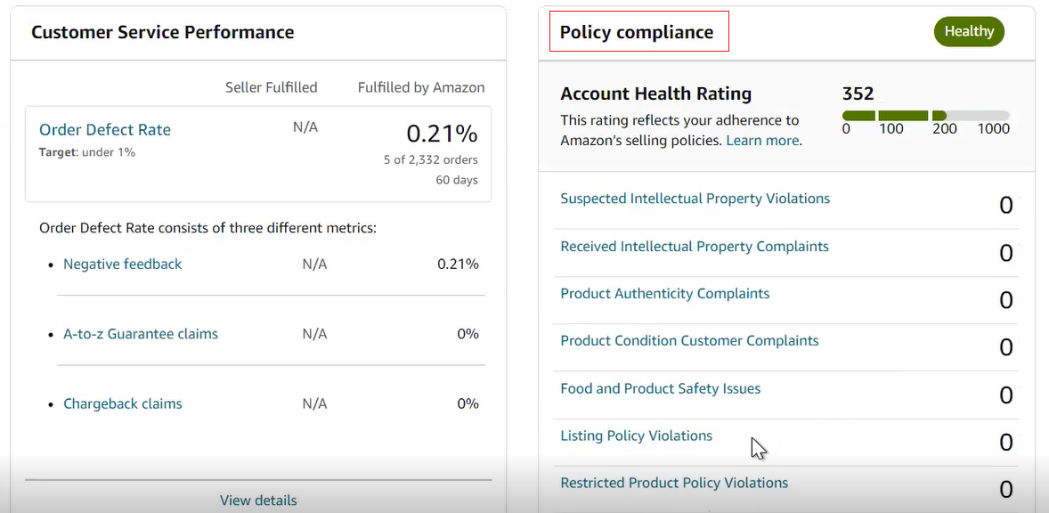
If a problem is found, it must be addressed by following the instructions provided by Amazon.
If there are no policy violations, you can find out the reasons why the product was blocked by analyzing marketplace notifications in the email inbox associated with the seller's account, or by sending a request to Amazon Support Center.
In order to send a request, go to the Help section on Amazon Seller Central and click the Get Support button at the bottom of the page.
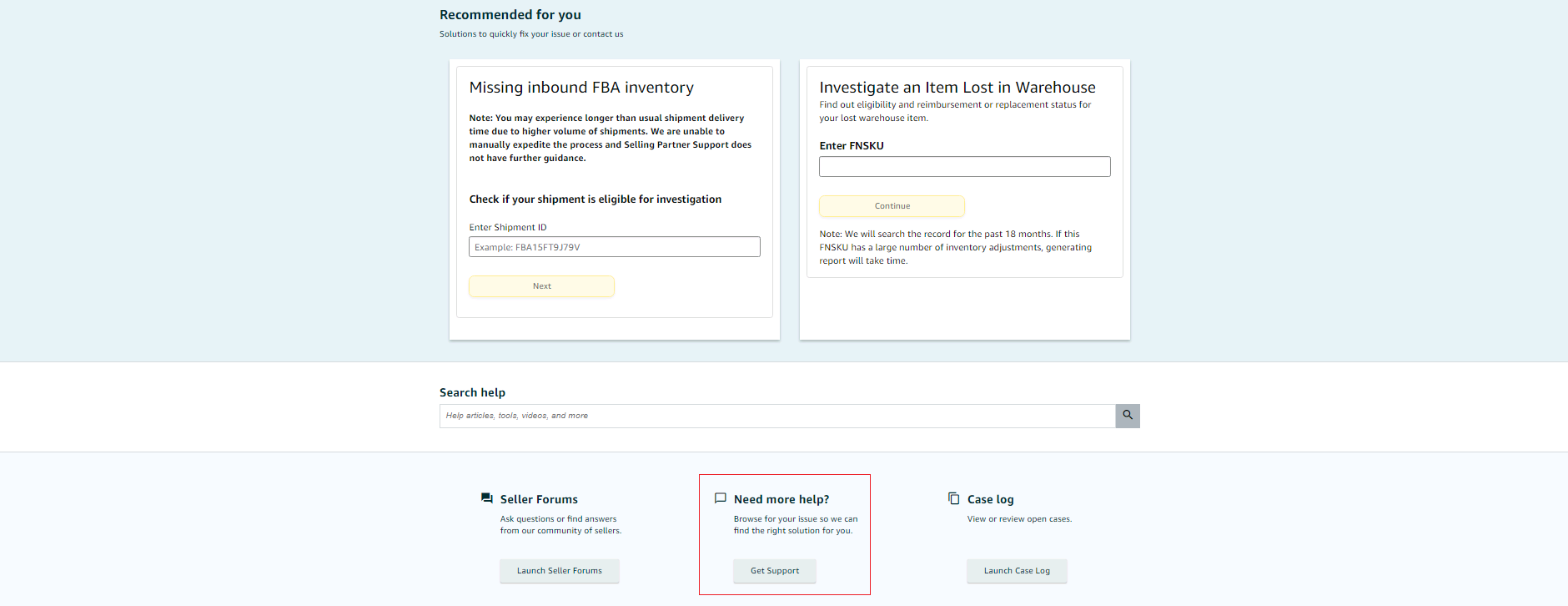
In the menu that appears on the screen, select the Selling on Amazon section. Then in the new Describe Your Issue window, instead of filling in the text box, we recommend clicking the link labeled Or, browse for your issue in the menu - this will allow you to more accurately describe the issue and speed up the processing of the request.
In the menu that appears after clicking the link, you must select Customer or Non-FBA Orders → Products, Listing, or Inventory → Investigate Other Product, Listings, or Inventory Issues.
After selecting the menu item, a contact form will be displayed in the right part of the window, where you can describe the problem and provide your email and phone number for communication.
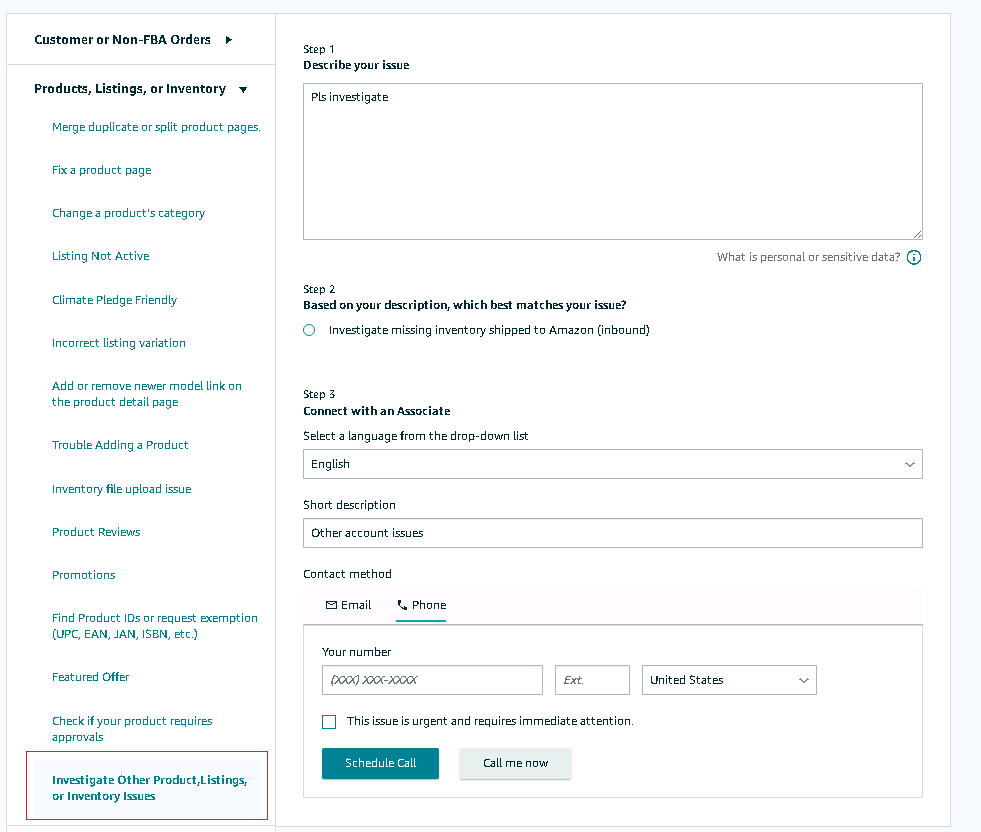
What to do if you receive
an Adult notification
The reason for a listing labeled as offering “adult products” may be something done by the marketplace or by dishonest actions of competitors or buyers. In any case, items marked as belonging to the Adult category are significantly limited in terms of search results, advertising opportunities, etc. Therefore, upon receiving an Adult notification for a listing that does not offer products in this category, you should immediately open a request in the Help section on Amazon Seller Central by clicking the Get Support button at the bottom of the page.
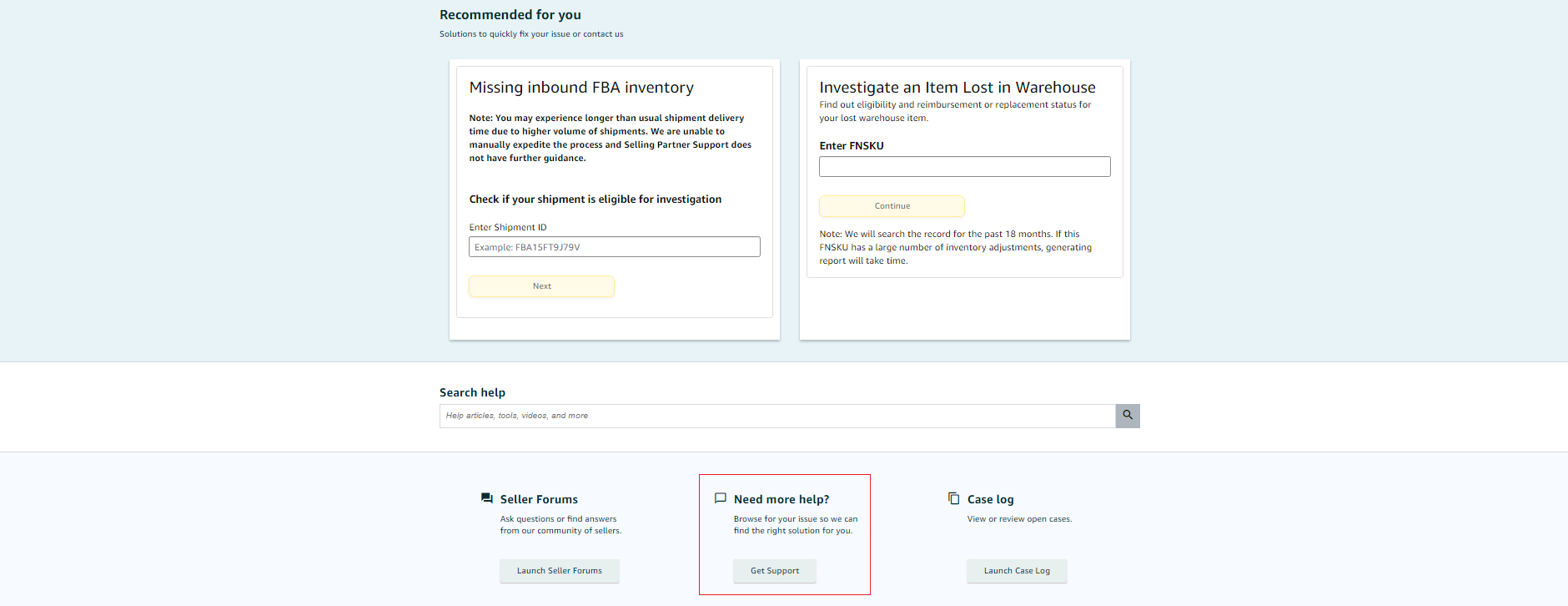
In the menu that appears, select the Selling on Amazon section. Then in the new Describe Your Issue window, describe the situation, and provide the ASIN and data that can confirm that the product on the listing is not an “adult product”.
In most cases, Amazon fixes the problem fairly quickly; however, for some items that may be categorized as Adult (for example, medical products, etc.), the marketplace may request additional information or documents, or require you to change the packaging: hide particular images, make it opaque, etc.
What to do if you receive
a Problems with Shipment notification
In the event of a Problems with Shipment notification, it is important to respond to it as quickly as possible. Depending on what type of problem requires additional information, Amazon may only provide a warning or block the invoice (shipment) along with the consignment of goods that arrived at the FBA warehouse. In some cases, invoices for all items in an account may be blocked.
To find out the reason for the request and what specific actions the marketplace expects from the seller, go to the menu on Amazon Seller Central and select Inventory → Manage FBA Shipments.

In the Shipping Queue window, a list of invoices (shipments) will be shown with their ShipmentID, Shipment name, when the invoice was Created / Last updated, the identifier of the warehouse to which the goods were sent (Ship to), number of SKUs, and the number of Units expected, as well as the status of the invoice.

When responding to a notification of problems with a product that has arrived at the FBA warehouse, you should pay attention to goods that have Closed status.
To find out more about the issue, click the View problems with this shipment link under ShipmentID and the invoice name.
Clicking this link opens a window with detailed information about the Problems with the goods/invoice.
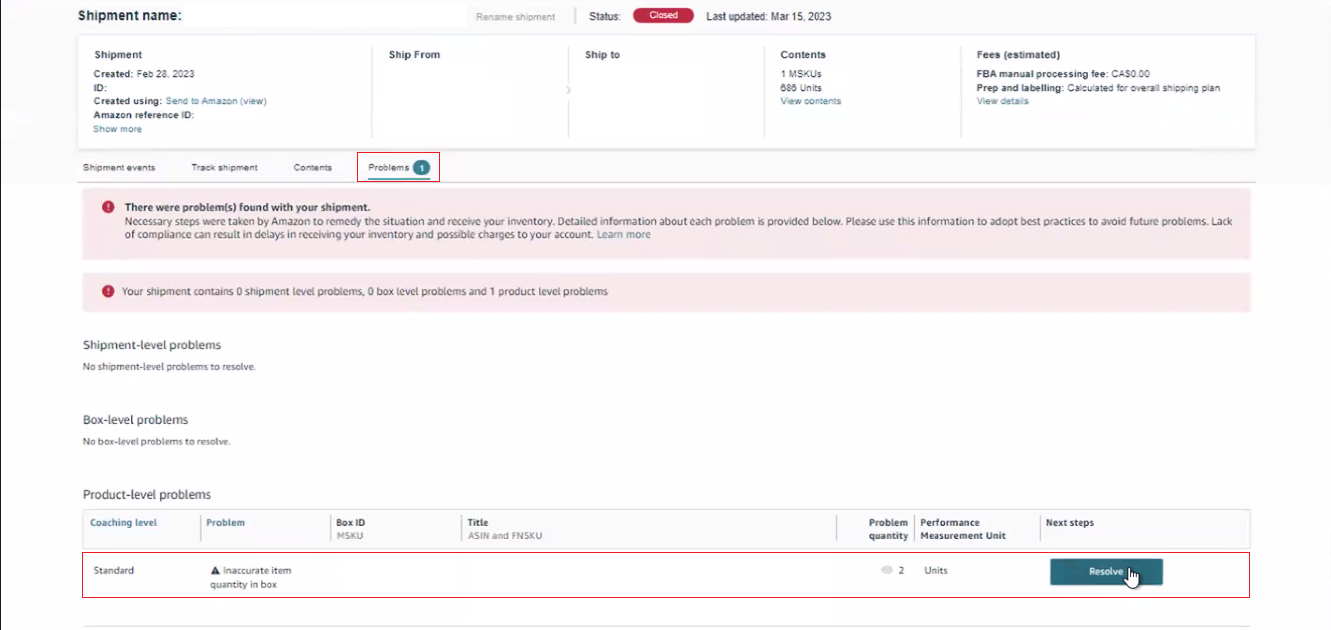
An item or invoice may have one or more types of problems:
- Shipment-level problems - problems with the invoice document;
- Box-level problems - for example, the number of boxes or the number of goods in a box is incorrectly indicated, or the weight and dimensions of the box are incorrectly indicated, etc.;
- Product-level problems - for example, the bar code is not readable, the packaging does not meet the requirements of the marketplace, etc.
Regardless of the type of problem, there is the Reserve button to the right of the description and data about the goods/box, which you can click to open the instructions for solving the problem.
Depending on the specific situation, the instructions may vary. Below is a sample of one set of instructions.
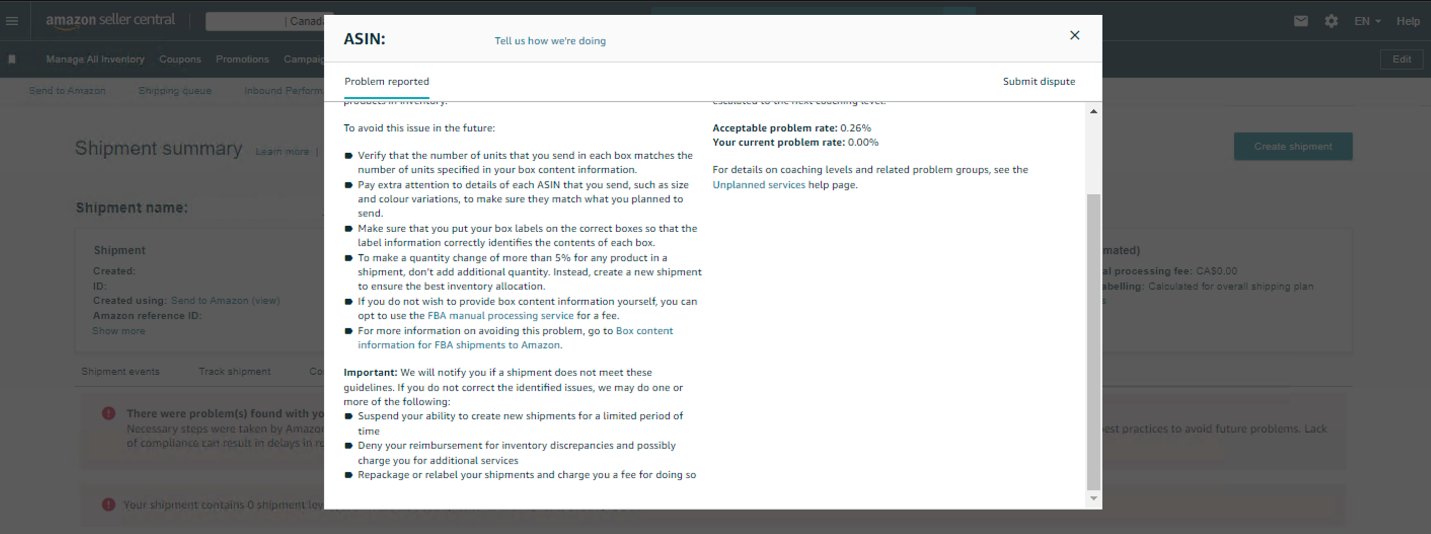
What to do when you receive
a Dimensions Changed notification
Learn more about the possible reasons for Amazon changing the dimensions of goods, as well as the rules for measuring the dimensions, weight, and dimensional weight of goods, in the "Guide on measuring dimensions, estimating Amazon FBA fees, and preparing a reimbursement claim to Amazon for excess fees”. This guide is available in the Help Hub of the Reimbursement Tool.
If you receive a notification about a change in the overall dimensions of the product and disagree with the new dimensions used by the marketplace for calculating fees, apply for re-measurement of the dimensions in the FBA warehouse by going to the Help section on Amazon Seller Central and clicking the Get Support button at the bottom of the page.
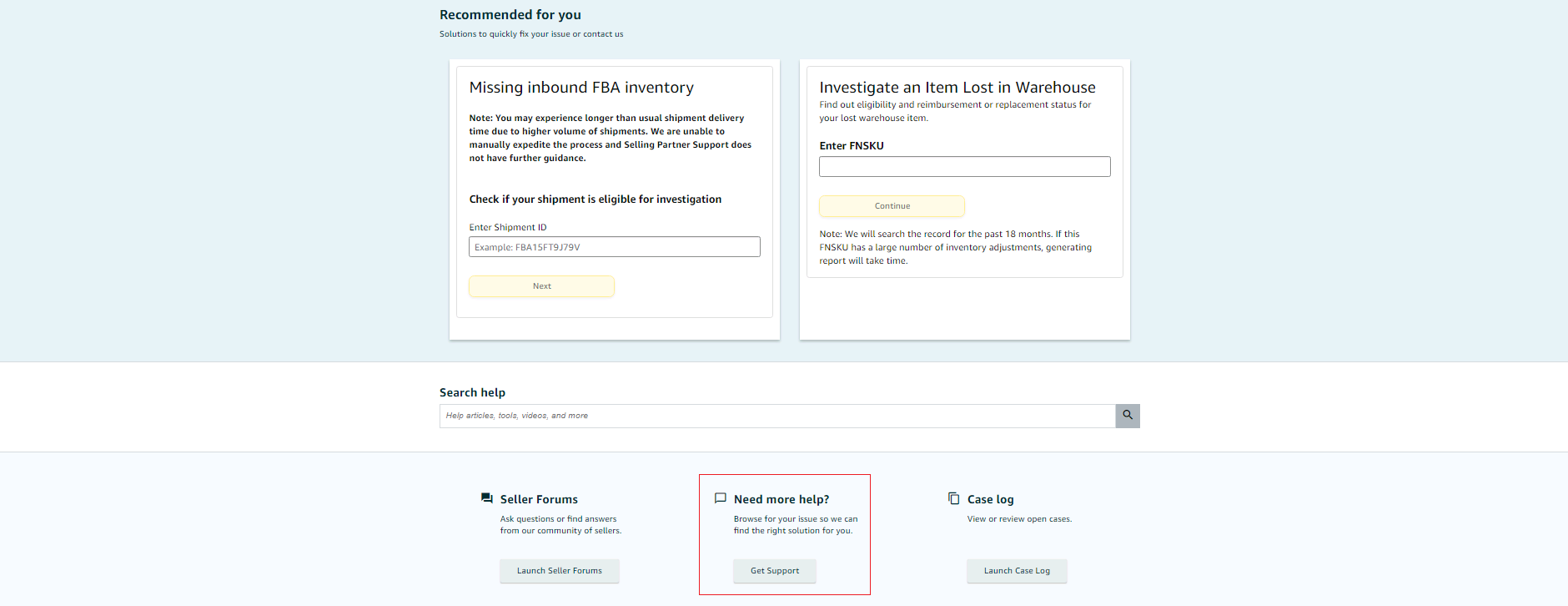
In the menu that appears, select the Selling on Amazon section. Then in the new Describe Your Issue window, instead of filling in the text box, we recommend you click the link labeled Or, browse for your issue in the menu - this will allow you to more accurately specify the issue and speed up the processing of the request.
In the menu that appears after clicking the link, select Fulfillment by Amazon → Investigate Other FBA Issues.
In the additional menu, click the Select Issue button next to Confirm / Request Reimbursement for Product Weights and Dimensions.
In the application panel that appears, you just need to fill in the fields, specifying ASIN / FNSKU and briefly describing the essence of the issue.
Also, we recommended you add a photo and video of the product, with a ruler showing its dimensions. You can do this by clicking Add attachments below the email address field.
It is important that the photo and video clearly show the barcode of the measured product, allowing the marketplace to match the product with a specific ASIN / FNSKU
To send your request to Amazon, click the Send button at the bottom of the block.
What to do if you receive
a Category Changed notification
Change of the product category can be caused by a routine Amazon procedure, when the marketplace, based on an analysis of the listing and search queries leading to a purchase, can initiate the transfer of a product to another category, or it can happen due to other reasons.
If you need to reset the product category to its original one, you can do this by selecting Inventory → Manage All Inventory on Amazon Seller Central.
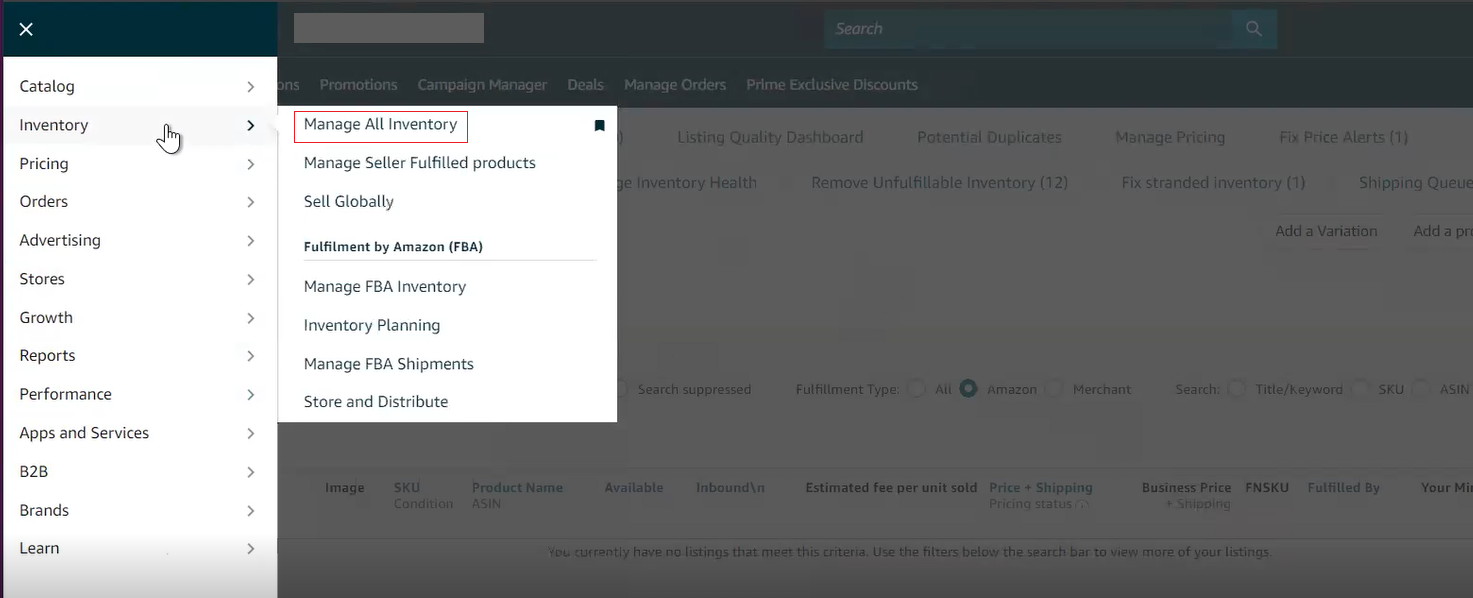
In the window that opens with a list of products, you should click the Edit button to the right of the name of the product whose category has been changed (this product is listed in the notification).
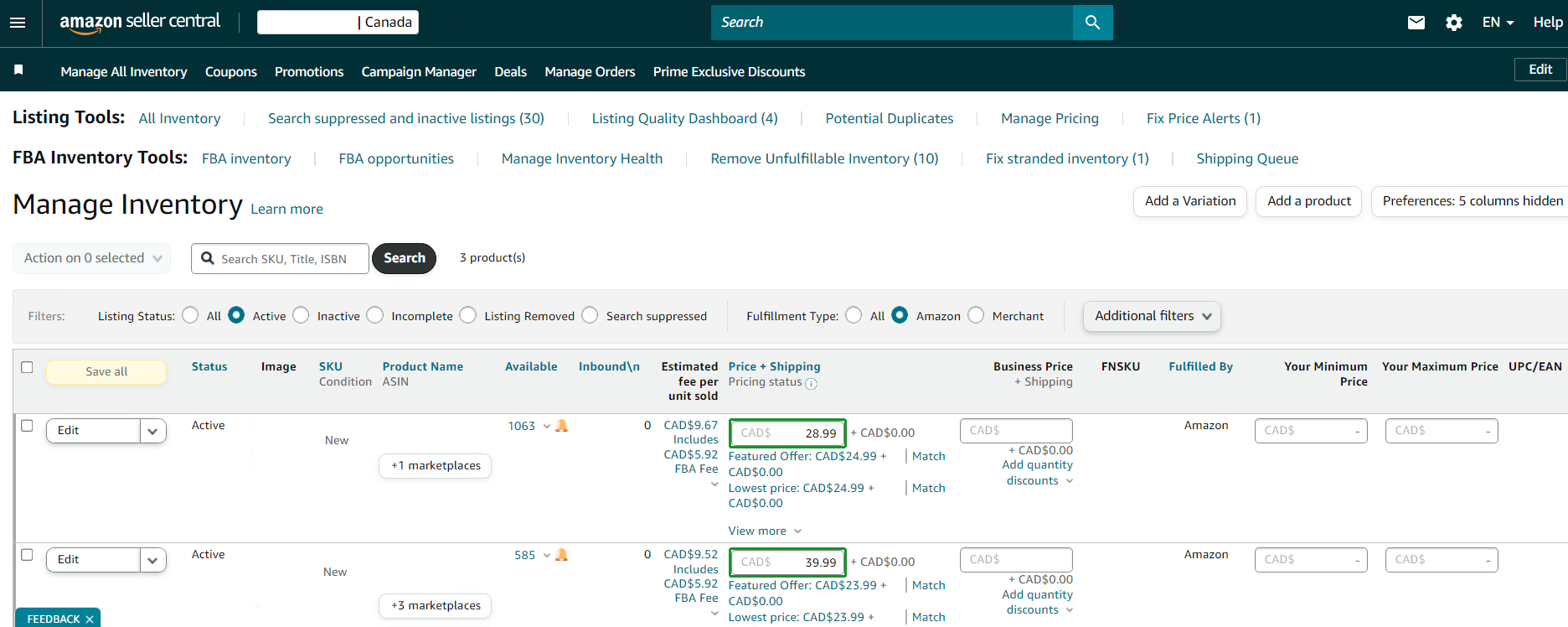
Next, in the product card, find the Category and change it to what you want. If it is not possible to change the parameter in the way described above (the Category is not displayed, or the marketplace has disabled changing it for the selected product), you can reset a category by submitting a request to Amazon Help Center.
To submit a request, go to Amazon Help Center, click the Get Support button at the bottom of the page, and then, in the window that opens, click Selling on Amazon.
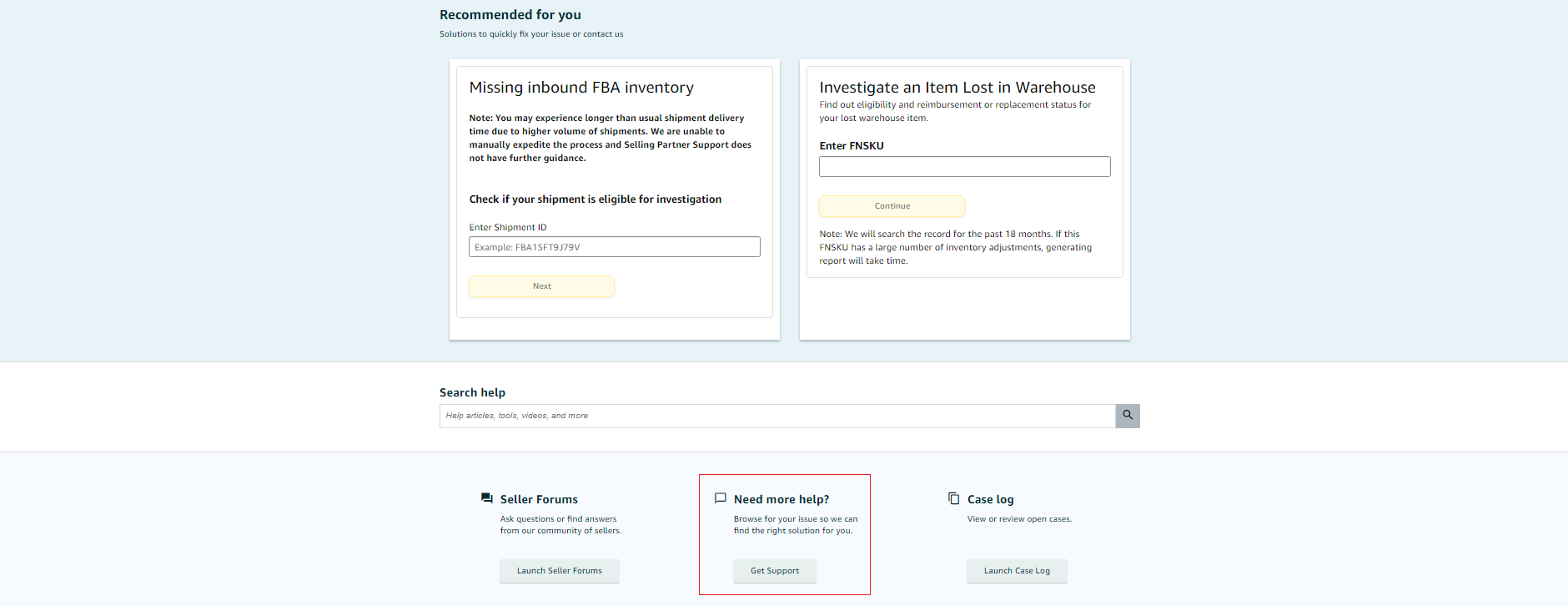
In the Get Support window, click Or, browse your issue in menu.
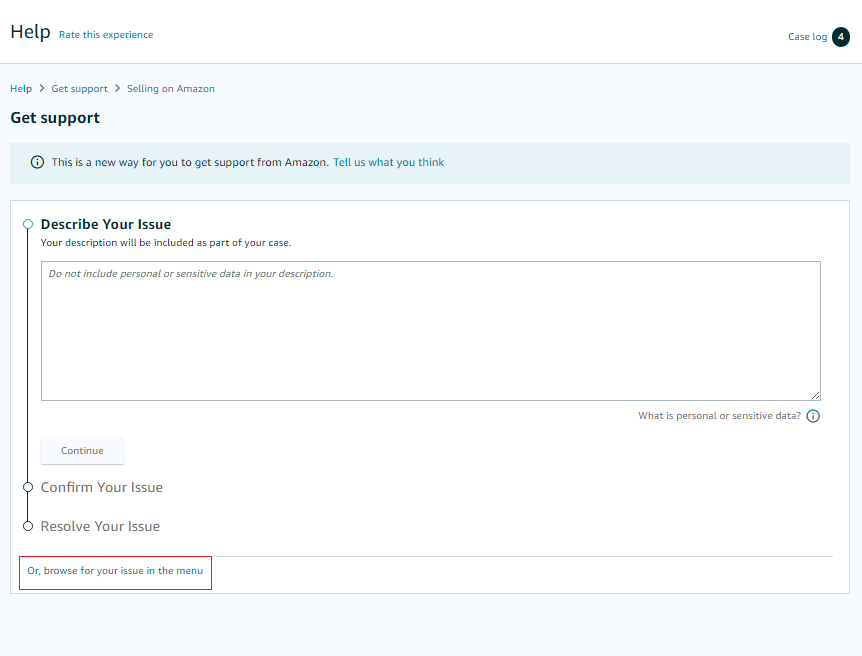
In the menu that appears, select Change a product’s category, which will open an input field in the right part of the window to enter the ASIN of the product whose category has been changed. After entering the data, click the Next button to indicate the desired category and send a request to Amazon.
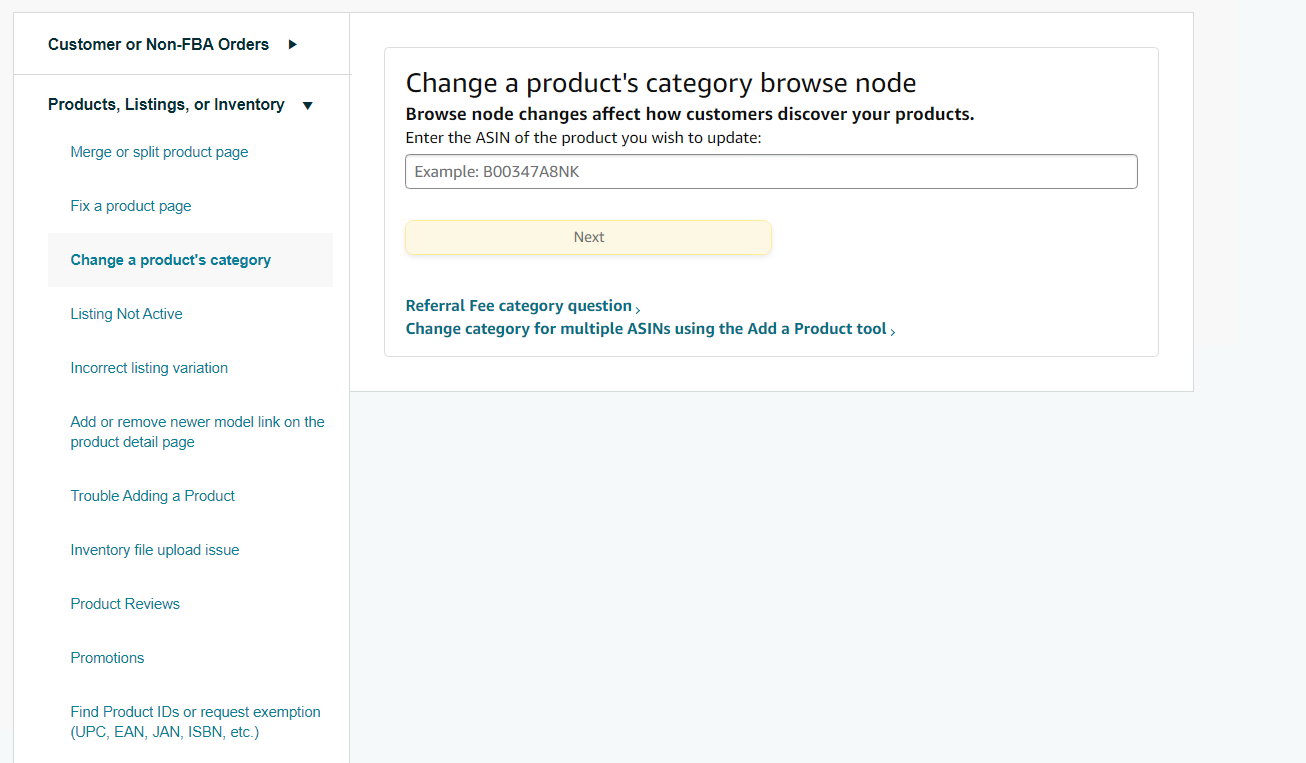
If changing the category is disabled, you should submit a support ticket for more information about the reasons for the category change and how to restore it.
Free 7 days trial. Cancel anytime.
Ready to separate yourself from the competition?



